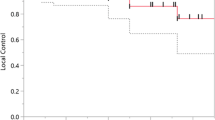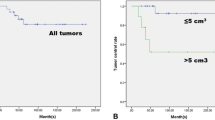Abstract
Introduction
We retrospectively evaluated the efficacy of three-dimensional conformal radiotherapy (3D-CRT) for spinal schwannoma.
Methods
Nine patients with spinal schwannoma were treated with 3D-CRT. All patients had a paravertebral or intraosseous component. Tumor sizes ranged from 0.8 to 8.7 cm, with a median of 3.5 cm. The prescribed dose was 50 Gy in 25 fractions at the isocenter, except for 1 patient who received 66 Gy in 33 fractions for a large sacral tumor. The follow-up period ranged from 20 to 137 months, with a median of 72 months.
Results
Tumor shrinkage within 3 mm occurred in 4 patients and tumor expansion within 3 mm occurred in 3. One tumor showed neither expansion nor shrinkage at the last follow-up. One patient experienced transient expansion by 8 mm in diameter at 12 months after the completion of radiotherapy (35–43 mm), and then the tumor size remained unchanged for 7 years. No severe late toxicity ≥ grade 3 was observed.
Conclusions
Only 1 of 9 tumors showed transit expansion over 3 mm after 3D-CRT, and severe late radiation toxicity was not observed. Use of 3D-CRT should be considered a treatment option for spinal schwannoma.



Similar content being viewed by others
References
Conti P, Pansini G, Mouchaty H, Capuano C, Conti R. Spinal neurinomas: retrospective analysis and long-term outcome of 179 consecutively operated cases and review of the literature. Surg Neurol. 2004;61(1):34–43 (discussion 4).
Seppala MT, Haltia MJ, Sankila RJ, Jaaskelainen JE, Heiskanen O. Long-term outcome after removal of spinal schwannoma: a clinicopathological study of 187 cases. J Neurosurg. 1995;83(4):621–6. doi:10.3171/jns.1995.83.4.0621.
Satoh N, Ueda Y, Koizumi M, Takeshima T, Iida J, Shigematsu K, et al. Assessment of pure single nerve root resection in the treatment of spinal schwannoma: focus on solitary spinal schwannomas located below the thoracolumbar junction. J Orthop Sci. 2011;16(2):148–55. doi:10.1007/s00776-011-0032-8.
Selch MT, Lin K, Agazaryan N, Tenn S, Gorgulho A, DeMarco JJ, et al. Initial clinical experience with image-guided linear accelerator-based spinal radiosurgery for treatment of benign nerve sheath tumors. Surg Neurol. 2009;72(6):668–74. doi:10.1016/j.surneu.2009.04.019 (discussion 74–5).
Sachdev S, Dodd RL, Chang SD, Soltys SG, Adler JR, Luxton G, et al. Stereotactic radiosurgery yields long-term control for benign intradural, extramedullary spinal tumors. Neurosurgery. 2011;69(3):533–9. doi:10.1227/NEU.0b013e318218db23 (discussion 9).
Gerszten PC, Burton SA, Ozhasoglu C, McCue KJ, Quinn AE. Radiosurgery for benign intradural spinal tumors. Neurosurgery. 2008;62(4):887–95. doi:10.1227/01.neu.0000318174.28461.fc (discussion 95–6).
Kirkpatrick JP, Meyer JJ, Marks LB. The linear-quadratic model is inappropriate to model high dose per fraction effects in radiosurgery. Semin Radiat Oncol. 2008;18(4):240–3. doi:10.1016/j.semradonc.2008.04.005.
Medin PM, Boike TP. Spinal cord tolerance in the age of spinal radiosurgery: lessons from preclinical studies. Int J Radiat Oncol Biol Phys. 2011;79(5):1302–9. doi:10.1016/j.ijrobp.2010.10.052.
Ryu S, Jin JY, Jin R, Rock J, Ajlouni M, Movsas B, et al. Partial volume tolerance of the spinal cord and complications of single-dose radiosurgery. Cancer. 2007;109(3):628–36. doi:10.1002/cncr.22442.
Varughese JK, Wentzel-Larsen T, Pedersen PH, Mahesparan R, Lund-Johansen M. Gamma knife treatment of growing vestibular schwannoma in norway: a prospective study. Int J Radiat Oncol Biol Phys. 2012;84(2):e161–6. doi:10.1016/j.ijrobp.2012.03.047.
Shirato H, Sakamoto T, Sawamura Y, Kagei K, Isu T, Kato T, et al. Comparison between observation policy and fractionated stereotactic radiotherapy (SRT) as an initial management for vestibular schwannoma. Int J Radiat Oncol Biol Phys. 1999;44(3):545–50.
Aoyama H, Onodera S, Takeichi N, Onimaru R, Terasaka S, Sawamura Y, et al. Symptomatic outcomes in relation to tumor expansion after fractionated stereotactic radiation therapy for vestibular schwannomas: single-institutional long-term experience. Int J Radiat Oncol Biol Phys. 2013;85(2):329–34. doi:10.1016/j.ijrobp.2012.05.003.
Onimaru R, Shirato H, Aoyama H, Kitakura K, Seki T, Hida K, et al. Calculation of rotational setup error using the real-time tracking radiation therapy (RTRT) system and its application to the treatment of spinal schwannoma. Int J Radiat Oncol Biol Phys. 2002;54(3):939–47.
Emami B, Lyman J, Brown A, Coia L, Goitein M, Munzenrider JE, et al. Tolerance of normal tissue to therapeutic irradiation. Int J Radiat Oncol Biol Phys. 1991;21(1):109–22.
Cox BW, Jackson A, Hunt M, Bilsky M, Yamada Y. Esophageal toxicity from high-dose, single-fraction paraspinal stereotactic radiosurgery. Int J Radiat Oncol Biol Phys. 2012;83(5):e661–7. doi:10.1016/j.ijrobp.2012.01.080.
Kirkpatrick JP, van der Kogel AJ, Schultheiss TE. Radiation dose-volume effects in the spinal cord. Int J Radiat Oncol Biol Phys. 2010;76(3 Suppl):S42–9. doi:10.1016/j.ijrobp.2009.04.095.
Ryu S, Fang Yin F, Rock J, Zhu J, Chu A, Kagan E, et al. Image-guided and intensity-modulated radiosurgery for patients with spinal metastasis. Cancer. 2003;97(8):2013–8. doi:10.1002/cncr.11296.
Furweger C, Drexler C, Kufeld M, Muacevic A, Wowra B, Schlaefer A. Patient motion and targeting accuracy in robotic spinal radiosurgery: 260 single-fraction fiducial-free cases. Int J Radiat Oncol Biol Phys. 2010;78(3):937–45. doi:10.1016/j.ijrobp.2009.11.030.
Jiang L, Lv Y, Liu XG, Ma QJ, Wei F, Dang GT, Liu ZJ. Results of surgical treatment of cervical dumbbell tumors: surgical approach and development of an anatomic classification system. Spine. 2009;34(12):1307–14.
Author information
Authors and Affiliations
Corresponding author
Ethics declarations
Funding
This work was supported in part by a Grant-in-Aid for Science Research from the Ministry of Education, Science, Sports and Culture, Japan.
Ethical statement
The Institutional Review Board at Hokkaido University Hospital approved this retrospective study in December 2012.
Conflict of interest
Hiroki Shirato received research findings from Shimadzu Corp., Hitachi Medico, and Hitachi Co., Ltd.
About this article
Cite this article
Onimaru, R., Hida, K., Takeda, N. et al. Three-dimensional conformal fractionated radiotherapy for spinal schwannoma with a paravertebral or an intraosseous component. Jpn J Radiol 33, 757–763 (2015). https://doi.org/10.1007/s11604-015-0492-4
Received:
Accepted:
Published:
Issue Date:
DOI: https://doi.org/10.1007/s11604-015-0492-4




